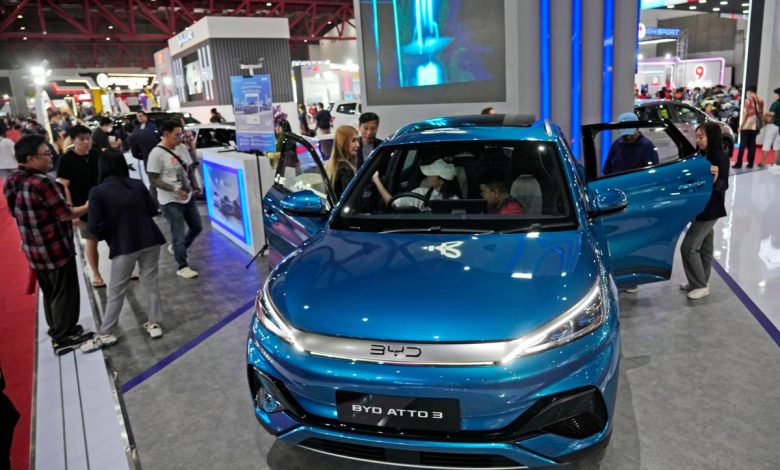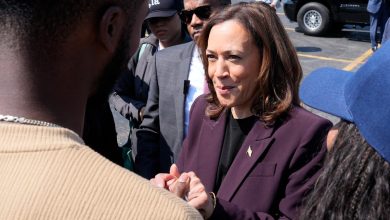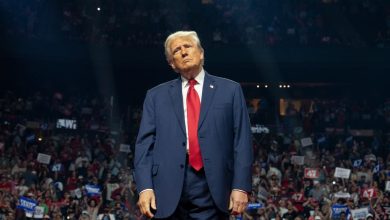Chinese firms eye Morocco as way to cash in on US electric vehicle subsidies

After the United States passed new subsidies designed to boost domestic electric vehicle production and cut into Beijing’s supply chain dominance, Chinese manufacturers began investing in an unlikely place: Morocco.
In the rolling hills near Tangiers and in industrial parks near the Atlantic Ocean, they have announced plans for new factories to make parts for EVs that may qualify for $7,500 credits to car buyers in the United States.
Similar investments have been announced in other countries that share free trade agreements with the United States, including South Korea and Mexico.
But few countries have seen the kind of boom that Morocco has.
At least eight Chinese battery makers have announced new investments in the North African kingdom since President Joe Biden signed the Inflation Reduction Act, the $430 billion U.S. law designed to fight climate change, according to an Associated Press tally.
By moving operations to U.S. trading partners like Morocco, Chinese players that have long dominated the battery supply chain are seeking a pathway to cash in on increasing demand from American carmakers like Tesla and General Motors, said Kevin Shang, a senior battery analyst at the consulting firm Wood Mackenzie.
“Chinese companies definitely don’t want to miss this big party,” he said.
The United States and European Union have both imposed major new tariffs on Chinese vehicle imports since May. The United States also finalized eligibility rules governing the tax credits in May. The latter limit companies with ties to U.S. adversaries, but give carmakers time to reduce their reliance on China. To qualify for the subsidies, carmakers cannot source critical minerals or battery parts from manufacturers in which China and other “foreign entities of concern” control more than 25% of the company or its board.
Critics say the rules are a giveaway to China and will extend its EV dominance. The Biden administration says the rules pave the way for billions in investment in EV manufacturing in the United States.
Between East and West
In Morocco, a largely agrarian economy where the median income is $2,150 a month, giant industrial parks full of American, European and Chinese component makers have sprung up in the rural outskirts of Tangiers, Kenitra and El Jadida.
Expanding on infrastructure that has made Morocco a car manufacturing hub, they hope to meet growing demand and overcome rules designed to exclude them from the incentives the Inflation Reduction Act is injecting into the U.S. car market, the world’s second-largest.
The rules “have led Chinese producers to increase investment in countries with whom the US has free trade agreements, namely South Korea and Morocco, to get past some IRA barriers,” the policy research firm Rhodium Group said in a report earlier this year.
Some of the new China investments in Morocco explicitly cite the new U.S. subsidies as a reason.
Many are joint ventures that have cited their ability to tinker with board seats and governance to comply with U.S. rules.
That includes CNGR, one of China’s largest battery cathode producers, which in September announced a $2 billion plan to build what it called a “base in the world and pan-Atlantic region” in a joint venture with the Moroccan royal family’s investment group, Al Mada.
Though CNGR owns slightly more than a 50% stake in the project, Thorsten Lahrs, CEO of its Europe division, said he’s confident its cathodes can qualify for the tax credits and change its board composition if necessary. If not, the company would pivot to other markets, including Europe, which just hiked tariffs on electric vehicles imported from China.
“To ride the wave of the IRA, you have to execute fast and comply with its regulations,” he said in an interview before the U.S. finalized its rules. “We have flexibility to be able to comply with all the changes in interpretation or rules.”
The Chinese battery projects include at least three joint ventures and several that reference Morocco’s trade ties with the United States.
The largest among them is Chinese-German battery-maker Gotion High-Tech, which signed a deal with Morocco last year for $6.4 billion investment to construct Africa’s first electric vehicle battery factory.
Investments also include Youshan, a joint venture backed by Korean giant LG Chem and China’s Huayou Cobalt. It declined to provide details about the size of their investment but said the Morocco base means their cathodes “will be supplied to the North American market and subsidized by the U.S. Inflation Reduction Act as Morocco is a signatory to the U.S. Free Trade Agreement.”
LG Chem said the venture would adjust ownership shares as necessary to comply with U.S. rules.
China’s BTR Group’s announcement of a cathode factory in April noted that Morocco’s trade status with the United States and Europe would ensure “a seamless entry for the majority of its manufactured products into these regions.”
Abdelmonim Amachraa, a supply chain expert who previously worked in Morocco’s Ministry of Industry and Trade, said Morocco was profiting from its “ability to coexist when a link can’t be found between China and the United States.”
Officials in Morocco have publicly and privately worked to foster ties up and down the automotive supply chain in both the East and the West. The country hosts more than 250 companies that manufacture cars or their components, including Stellantis and Renault as well as Chinese, Japanese, American and Korean factories that make seats, engines, shock absorbers and wheels. The industry exports almost $14 billion in cars and parts annually.
As the world transitions to electric vehicles, Morocco may appear to be a surprising beneficiary as China, the United States and Europe compete for market share. But its officials worry that anti-competitive policies like tariffs and subsidies could ultimately make it more difficult to lure investment.
Ryad Mezzour, the country’s minister of industry and trade, said in an interview that all the new investment doesn’t tell the full story. Morocco has also lost out on some projects due to what he called “a new age of protectionism.”
A giant loophole
The investment has been a boon to countries like Morocco. But in Washington, Chinese firms have raised alarm by angling to access the American subsidies.
“Under the Biden administration’s electric vehicle regulations, America’s working families will have to watch their hard-earned tax dollars go to line the pockets of Chinese billionaires and businesses with links to the Chinese Communist Party,” U.S. Rep. Jason Smith, a Missouri Republican, said of the new guidelines.
But at issue are the complexities of both the electric vehicle supply chain and the Inflation Reduction Act, which seeks to grow adoption of EVs and boost domestic manufacturing, too.
The U.S. Energy and Treasury departments have tried to strike a delicate balance, working to reduce reliance on Chinese manufacturers while also ensuring enough vehicles qualify for the credits. The Department of Energy did not respond to questions about what its rules meant for Chinese investments in countries that share free trade agreements with the United States. But in a statement, a spokesperson called the transition to electric vehicles “an industry-wide, global trend” and said new policies “help the US strengthen its energy security and competitiveness—including outcompeting China.”
China has spent years subsidizing companies that extract critical battery minerals, manufacturers of cathodes, anodes and electrolyzers and carmakers like BYD. Those companies’ eagerness to invest in Morocco to cash in on the Inflation Reduction Act shows how decoupling Chinese manufacturers from the supply chain will take years, if not decades, said Chris Berry, an adviser to battery companies and investors.
“There is not going to be a lithium ion battery supply chain that does not have Chinese influence for a long time,” Berry said.
___
The Associated Press’ climate and environmental coverage receives financial support from multiple private foundations. AP is solely responsible for all content. Find AP’s standards for working with philanthropies, a list of supporters and funded coverage areas at AP.org.







